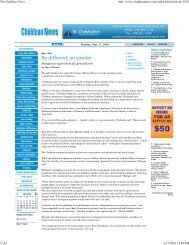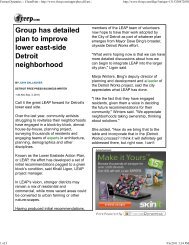View - Data Driven Detroit
View - Data Driven Detroit
View - Data Driven Detroit
Create successful ePaper yourself
Turn your PDF publications into a flip-book with our unique Google optimized e-Paper software.
x<br />
<strong>Detroit</strong> Free Press 02/20/2010<br />
Copy Reduced to 65% from original to fit letter page<br />
Page : A09<br />
x<br />
HOUSING IN DETROIT➧COVER STORY<br />
◆ SATURDAY, FEB. 20, 2010 WWW.FREEP.COM 9A<br />
A block in the Middle Woodward neighborhood shows a high-occupancy area of the city.<br />
Google Street <strong>View</strong><br />
Many are gone, but more remain<br />
Most occupied houses in<br />
<strong>Detroit</strong> still OK but amid<br />
vacant lots, survey finds<br />
By JOHN GALLAGHER<br />
FREE PRESS BUSINESS WRITER<br />
A mammoth new survey delivers<br />
a sharply focused look at<br />
<strong>Detroit</strong>’s housing stock and<br />
lays the groundwork for a<br />
sweeping debate about rightsizing<br />
the city.<br />
The survey by the <strong>Detroit</strong><br />
<strong>Data</strong> Collaborative gives an<br />
unprecedented view of the<br />
strengths and weaknesses of<br />
the city’s residential areas. Results<br />
portray a city of marked<br />
contrasts.<br />
A little more than 35% of the<br />
city’s 343,849 residential parcels<br />
are either vacant lots or<br />
abandoned shells of buildings<br />
— a staggering burden for a city<br />
trying to reinvent itself.<br />
But the survey also found<br />
surprisingly upbeat results in<br />
<strong>Detroit</strong>’s most vital districts.<br />
The survey found that more<br />
than 90% of the city’s occupied<br />
residential units are in good or<br />
fair condition — results that<br />
could lay the foundation for efforts<br />
to strengthen individual<br />
neighborhoods.<br />
If nothing else, the survey<br />
promises to plug some giant<br />
holes in the city’s understanding<br />
of itself. <strong>Detroit</strong> planners<br />
now have an accurate mapping<br />
of vacancy as well as precise<br />
data on the condition of individual<br />
residential parcels.<br />
Those should prove crucial for<br />
planning everything from private<br />
investment to government<br />
aid.<br />
“I am absolutely delighted<br />
that that information has been<br />
released,” said Robin Boyle,<br />
chairman of the urban planning<br />
department at Wayne<br />
State University. “I think it’s<br />
going to be a very important<br />
step in moving the city forward<br />
in terms of understanding<br />
what we have in vacancy,<br />
where the vacant properties<br />
are, and how we can start to<br />
move toward consolidation of<br />
these.”<br />
Todd Swanstrom, a professor<br />
of public policy at the University<br />
of Missouri, agreed.<br />
“The data is the first step,”<br />
What could fill<br />
the vacancy?<br />
Community leaders and city<br />
planners are trying to find new<br />
uses for <strong>Detroit</strong>’s empty spaces.<br />
Urban agriculture is getting a<br />
lot of attention as a possible<br />
use for the parcels. Residents<br />
already plant several hundred<br />
community gardens each year.<br />
Activists also are mapping a<br />
network of greenways — nonmotorized<br />
transportation corridors<br />
such as the Dequindre Cut<br />
— throughout the city.<br />
Some planners would like to<br />
create windmill farms and<br />
other alternative energy centers<br />
in <strong>Detroit</strong>’s open spaces.<br />
What’s next?<br />
The <strong>Detroit</strong> <strong>Data</strong> Collaborative<br />
wants to work with<br />
community groups and others<br />
to put its survey results to<br />
productive use. Software will<br />
permit users to create precise<br />
maps of conditions in specific<br />
neighborhoods.<br />
In this initial survey, the<br />
collaborative looked at only<br />
single-family houses and residential<br />
buildings with up to<br />
four units. When money becomes<br />
available, a future survey<br />
could look at larger residential<br />
units — apartment and<br />
condominium buildings — as<br />
well as commercial, retail and<br />
industrial parcels in the city.<br />
he said. “Nonprofits and private<br />
investors and others now<br />
will have much more information<br />
about where properties<br />
are available, and to market<br />
them in some sort of more systematic<br />
way.”<br />
To the math-phobic, the<br />
mountain of new data may<br />
seem arcane or even boring.<br />
But to decision-makers, the<br />
survey promises to mark a leap<br />
forward in tackling <strong>Detroit</strong>’s<br />
problems. In a world where investment<br />
decisions and government<br />
aid are driven by hard<br />
data, the survey offers an unblinking,<br />
parcel-by-parcel look<br />
of <strong>Detroit</strong>’s condition.<br />
Copyright Use of this © site 2010 indicates <strong>Detroit</strong> your Free Press agreement Inc.<br />
Terms of Service and Privacy Policy , updated to the<br />
9/21/05.<br />
A CITY OF CONTRASTS<br />
The condition of <strong>Detroit</strong>’s housing stock varies widely across the city. Many stronger neighborhoods, like<br />
some on the northwest or far east sides as seen in the yellow areas of the map, are composed almost<br />
solidly of homes in good condition. But many districts in the inner core of <strong>Detroit</strong> contain homes mostly<br />
in poor condition.<br />
Ratings of average<br />
housing conditions<br />
Strongest<br />
Moderately strong<br />
Moderately weak<br />
Weakest<br />
Unsurveyed<br />
NOTE: Includes single, duplex and<br />
multi-unit houses up to four units.<br />
1 mile<br />
City of<br />
Highland<br />
Park<br />
Source: <strong>Detroit</strong> Residential Parcel Survey<br />
By the numbers<br />
City of<br />
Hamtramck<br />
26%<br />
of the city’s residential parcels<br />
are vacant lots.<br />
95%<br />
of <strong>Detroit</strong> homes are deemed<br />
suitable for occupancy.<br />
“We really feel you’ve got to<br />
be able to show the data,” said<br />
Kurt Metzger, a demographer<br />
and director of the nonprofit<br />
agency <strong>Data</strong> <strong>Driven</strong> <strong>Detroit</strong>,<br />
which helped manage the survey.<br />
“You’ve got to be able to<br />
show that you have the capacity<br />
to understand what’s there<br />
and to measure outcomes and<br />
the return on investment.”<br />
The survey results will be<br />
available online at www.<br />
detroitparcelsurvey.org. As<br />
a safety precaution, the public<br />
will be allowed to access data<br />
only at the block level or larger,<br />
not the condition of individual<br />
houses. Gregory Parrish, data<br />
manager for <strong>Data</strong> <strong>Driven</strong> <strong>Detroit</strong>,<br />
said that will prevent<br />
criminals from using the survey<br />
data to target empty houses.<br />
Community groups, researchers<br />
and others will be<br />
able to work with <strong>Data</strong> <strong>Driven</strong><br />
<strong>Detroit</strong> to create detailed maps<br />
of individual districts for<br />
study. And, in the future, the<br />
agency hopes to add advanced<br />
mapping software and other<br />
tools to its Web site to make<br />
the survey results more accessible<br />
and useful.<br />
“We’re hoping for a pretty<br />
wide audience,” Parrish said.<br />
“It should be useable by anyone<br />
and everyone.”<br />
Many of the results confirm<br />
what other indicators of <strong>Detroit</strong>’s<br />
distress have shown.<br />
For example, two out of the<br />
three areas with the highest<br />
vacant housing rates can be<br />
found in the 48205 ZIP code, an<br />
east side area the Free Press<br />
has identified as having the<br />
highest foreclosure rate<br />
among metro communities.<br />
The survey, detailed as it is,<br />
marks only a first step. It did<br />
not consider commercial, industrial<br />
or retail parcels, nor<br />
HOUSE CONDITIONS<br />
Here’s a breakdown of the conditions<br />
of the city’s single-family units.<br />
86% good<br />
9% fair<br />
3% poor<br />
1% should be<br />
demolished<br />
Does not add up to 100% because of rounding.<br />
MARTHA THIERRY and MOSES HARRIS/<strong>Detroit</strong> Free Press<br />
9%<br />
of homes are generally in need<br />
of minor repair.<br />
86%<br />
of <strong>Detroit</strong>’s single-family<br />
homes are in good condition.<br />
Source: <strong>Detroit</strong> <strong>Data</strong> Collaborative<br />
was it able to consider apartment<br />
and condominium buildings<br />
larger than four units. Future<br />
surveys will need to tackle<br />
those parcels.<br />
But Metzger said the parcel<br />
data eventually could be<br />
merged with other databases<br />
— foreclosures, health and educational<br />
statistics, crime patterns<br />
— to allow the most precise<br />
imaging ever of a city and<br />
its challenges.<br />
Boyle agreed.<br />
“I think we’re beginning to<br />
build a strong picture of what<br />
this city is like,” Boyle said.<br />
“We are very special. It’s a<br />
unique city in terms of the<br />
amount of vacancy and empty<br />
How survey was done<br />
The <strong>Detroit</strong> Residential Parcel<br />
Survey was conducted<br />
during August and September<br />
using about 50 University of<br />
Michigan students and <strong>Detroit</strong><br />
residents working in threeperson<br />
teams.<br />
Each team consisted of a<br />
driver and two spotters who<br />
rated the condition of individual<br />
residential parcels on each<br />
<strong>Detroit</strong> street. The teams had<br />
maps, lists of parcels and GPS<br />
units. They were trained to<br />
assess the condition of each<br />
parcel, looking for signs of<br />
occupancy or vacancy as well as<br />
the overall condition, including<br />
evidence of fire damage or<br />
houses that seemed suitable<br />
for demolition.<br />
The teams did not leave their<br />
vehicles but made their assessments<br />
using visual inspections.<br />
U-M’s Ginsberg Center, which<br />
organizes community service<br />
projects, recruited and managed<br />
the survey crews. The<br />
nonprofit agency <strong>Data</strong> <strong>Driven</strong><br />
<strong>Detroit</strong> manages the data and<br />
the Web site www<br />
.detroitparcelsurvey.org.<br />
<strong>Detroit</strong>’s Office of Foreclosure<br />
Prevention and Response<br />
administered the overall project.<br />
The nonprofit Community<br />
Legal Resources’ <strong>Detroit</strong> Vacant<br />
Property Campaign provided<br />
technical assistance and<br />
training, and will work with<br />
community groups that will be<br />
using the data.<br />
See the results<br />
To view more results of the<br />
parcel survey, go to www<br />
.detroitparcelsurvey.org. The<br />
site is expected to be up and<br />
running this weekend.<br />
property, and I think we need<br />
to get a very, very firm handle<br />
on what that is to move forward.”<br />
Mayor Dave Bing’s office<br />
said the survey “can serve as a<br />
component in the decisionmaking<br />
and strategic process<br />
for the city as we look to develop<br />
a land use plan and demolition<br />
strategy for the city.”<br />
❚ CONTACT JOHN GALLAGHER: 313-222-5173<br />
OR GALLAGHER@FREEPRESS.COM<br />
We drove every street<br />
One city, 2,100 streets, 2,700 miles.<br />
Revisit our snapshot of the city:<br />
freep.com/Driving<strong>Detroit</strong><br />
Lawyer: Professor shows signs of mental illness<br />
February 20, 2010 11:06 pm / Powered by TECNAVIA





